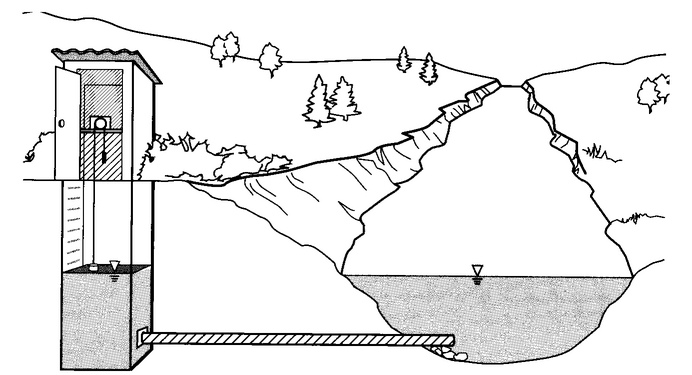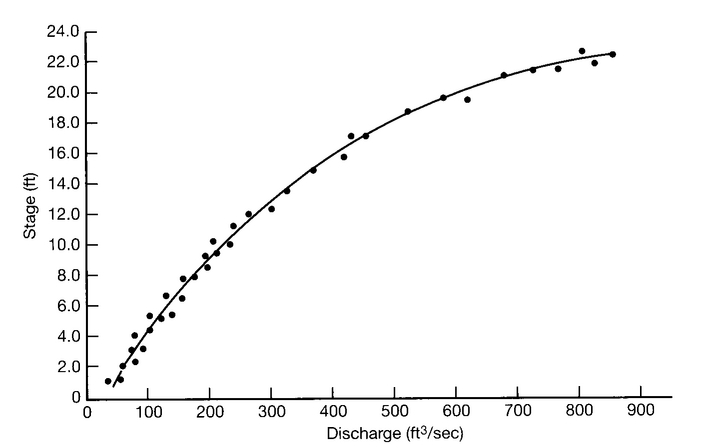



Next: Gauging Activities
Up: Streamflow/Stream Gauging
Previous: Streamflow/Stream Gauging
Subsections
Gauging Background
Stream gauging is performed to accurately determine the volume of
water moving past a given point per time. This information is crucial
for flood planning and prevention, as well as prediction of
sediment or contaminant transport, total contaminant or sediment load,
prediction and control of erosion, etc. The U.S. Geological Survey
maintains a number of real-time stream gauging sites in the
U.S. (accessible online) for these purposes.
 N. Fork Trinity River at McKinney
N. Fork Trinity River at McKinney
- The nearest such gauge is
near the Heard Museum at McKinney. Click
here
to see this month's data, see Fig. 3.1 for last
two-year's discharge
 Map of Texas Gauges
Map of Texas Gauges
- Map
showing current surface water summary and station locations for Texas
 Mississippi River at Baton Rouge
Mississippi River at Baton Rouge
- Gauge height data
for last 30 days. Note that maximum annual discharge averages 300,000
cubic ft/sec (cfs).
 Map of US Real-Time Data
Map of US Real-Time Data
- Map
showing current surface water summary and station locations for U.S.
Figure 3.1:
Discharge, East Fork Trinity River at McKinney Jan. 2005-May
2007. Heard wetlands fill whenever Trinity discharge exceeds
1000 cfs (horizontal line).
|
|
 Discharge
Discharge
- is the volume per unit time that passes any
point in a stream. Direct measurement of discharge is not
possible, but must be calculated from velocity and
cross-sectional area of the stream, i.e. from the Discharge
Equation
 |
(3.1) |
 Velocity
Velocity
- is the rate of water movement
(Fig. 3.7), but doesn't specify how much (volume of) water is
moving. The volume rate is needed to determine flooding, etc.
 Cross-sectional Area
Cross-sectional Area
- is the area on a vertical plane cutting
the stream (Fig. 3.2)
 Stage
Stage
- is the elevation of the river above its bed, i.e.
water depth
You've had direct experience with discharge when using a garden hose
with a nozzle. For a given faucet setting (constant input discharge)
water shoots farther out of the end of the hose (has higher velocity)
when a the nozzle is narrowed (cross-sectional area is reduced).
Velocity varies along a stream because of changes in cross-sectional
area, but discharge varies only if there is addition or removal
of water (e.g. tributaries, evaporation, etc.)
The simplest approach to measuring cross-sectional area is to locate a
number of points on the stream bottom by measuring down from the
tagline (or yardstick) at regular intervals (see `` '' in
Fig. 3.2. Then draw these locations (and the
water surface) to scale on graph paper, and count the squares to
determine the area. A second method is to approximate the area by a
series of rectangles, as shown in Fig. 3.2 and
Table 3.2, Sanders (1998). If you measure depth at regular
intervals (e.g. 2 cm), then the width
'' in
Fig. 3.2. Then draw these locations (and the
water surface) to scale on graph paper, and count the squares to
determine the area. A second method is to approximate the area by a
series of rectangles, as shown in Fig. 3.2 and
Table 3.2, Sanders (1998). If you measure depth at regular
intervals (e.g. 2 cm), then the width  of each rectangle is
constant.
of each rectangle is
constant.
Figure 3.2:
Measurement of
stream cross-sectional area (after Fig. 3.21, Sanders, 1998).
|
|
Figure 3.3:
Students gauging
Cottonwood Creek, UTD. When creek is ``bankfull'' taglines will be
used (as shown), when creek is low, yardsticks will replace the
taglines and centimeter rulers will be used to measure depths.
|
|
Figure 3.4:
Looking downstream from bridge to gazebo, Aug. 15, 2005
flood, taken at 1927h. Larger cross-section of outer channel
easily handles storm discharge, culverts at downstream end of
channel limit outflow and downstream flooding.
|
|
Figure 3.5:
Flood recession, Aug.15 2005,
looking westward at ``Library'' bridge (stream flowing right to
left). Fig. 3.5(b) taken 20 minutes after
Fig. 3.5(a), showing designed temporary
retention of stormwater by this structure. About 0.5 inches of
rain fell in the hour prior to this flood event.
[1926h]
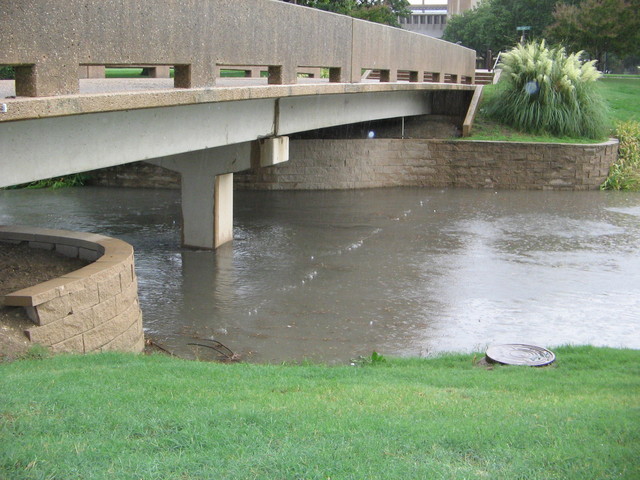
[1948h]
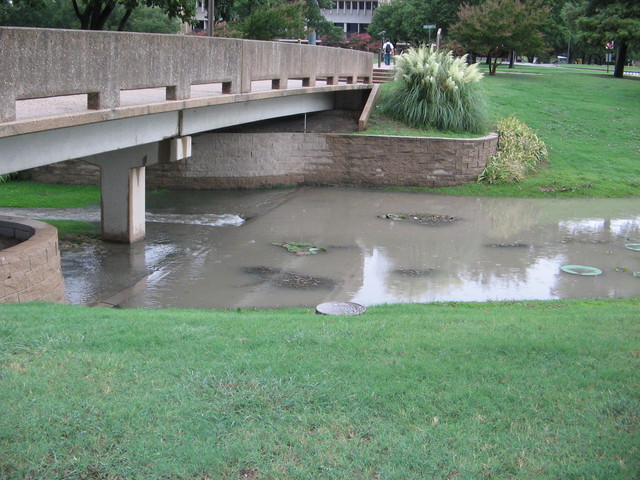
|
Velocity can be measured directly, using a flowmeter (essentially a
speedometer for water, Fig. 3.10 and Section
3.1.3) or inferred by timing the movement of a float in
the water (Fig. 3.7). Velocity varies across a stream
and with depth, depending primarily on the proximity of the streambed
(Fig. 3.6). When using a flowmeter, a single
measurement at approximately 60% of the depth of the stream will give
a reliable vertical average.
Figure 3.6:
Variation of stream
velocity with depth (after Fig. 3.16, Sanders, 1998).
|
|
Figure 3.7:
The float
method for velocity determination (after Fig. 3.17,
Sanders, 1998).
|
|
Figure 3.8:
Students using the float method for velocity measurement
(click on image for full-sized version). Fall '98 class, at Spring
Creek, Richardson, Texas.
|
|
Using the Flowmeter
The flowmeter can be used to determine average velocity at a point, or
across the entire stream (for small streams). The device is
waterproof, but try to avoid submerging the LCD display. To use the
flowmeter to measure stream velocity:
- make sure the prop turns freely
- note the measurement units, ``mi'' on the lower right side of
the display denotes english (ft/sec) units, ``km'' denotes
metric (m/sec)
- point the prop directly along the flow, with the black arrow on the
prop housing pointing downstream (with the flow). The prop
should be fully submerged.
- press the right button until ``V'' (velocity) appears
The instantaneous velocity (in meters/sec) is displayed as
the top number on the LCD screen.
- press the left button to set the lower display to ``av'' for
average velocity (initially this number is the maximum ``mx''
velocity)
- press and hold both left and right buttons simultaneously for
2 seconds to zero the display, and start measurement
- for point measurements, hold in the flow until the average
velocity is constant, then remove the probe. Measurement
(averaging) ceases when the prop stops turning, so the displayed
value is the true average at the point.
- for areal measurements (average
velocity over a stream
cross-section) move the probe in the flow in a steady
back-and-forth motion, as if you were spray-painting. When the
entire cross-section has been covered, remove the probe from the
flow, and record the displayed value.
Figure 3.9:
Impeller flowmeter. After
http://www.globalw.com/graphics/flow.jpg.
|
|
Figure 3.10:
Students using an
impeller flowmeter (click on image for full-sized version). Fall '98
class, at Spring Creek, Richardson, Texas.
![\begin{figure}\centering\includegraphics[height=3in,bb=0 0 639 479]
{Figs/flowmeter_use.eps.gz}\end{figure}](Timg16.gif) |
The links in Section 3.1 show up-to-the-minute
discharge at USGS and Army Corp of Engineers stream gauges. The
procedure described above is too cumbersome to provide such data,
instead it is derived from constant stream level (stage) monitoring
using ``Stilling wells'' (Fig. 3.11), from which
discharge is estimated using a ``rating curve'' (Fig. 3.12) for that site. The rating curve is derived by using the
procedure we'll use in this lab for a variety of discharge levels.
Figure 3.11:
Schematic of stream water level monitoring station (after
Fig. 3.17, Sanders, 1998). The configuration shown is known as a ``Stilling
well'', most stations simply have a PVC tube in place of the well.
|
|
Figure 3.12:
Example
rating curve for a stream gauging station (after Fig. 3.22,
Sanders, 1998). Given measurements of discharge at various river
levels (stage), the rating curve can be obtained and used to estimate
dischage given a stage measurement.x
|
|




Next: Gauging Activities
Up: Streamflow/Stream Gauging
Previous: Streamflow/Stream Gauging
GEOS 3110 Professor's Notes, Summer 2007
Dr. T. Brikowski, U. Texas-Dallas. All rights reserved.
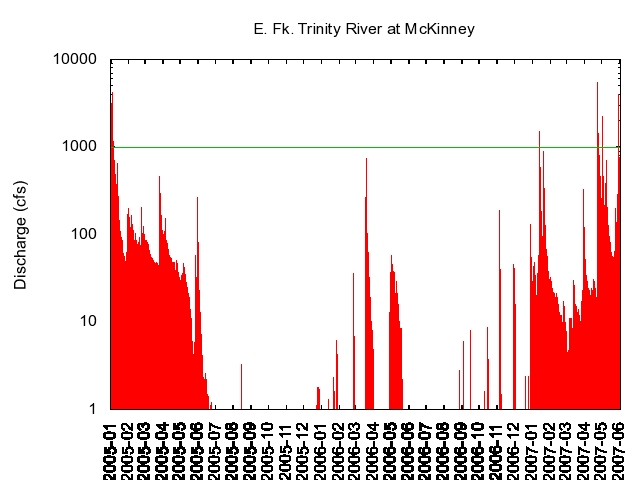
![]() '' in
Fig. 3.2. Then draw these locations (and the
water surface) to scale on graph paper, and count the squares to
determine the area. A second method is to approximate the area by a
series of rectangles, as shown in Fig. 3.2 and
Table 3.2, Sanders (1998). If you measure depth at regular
intervals (e.g. 2 cm), then the width
'' in
Fig. 3.2. Then draw these locations (and the
water surface) to scale on graph paper, and count the squares to
determine the area. A second method is to approximate the area by a
series of rectangles, as shown in Fig. 3.2 and
Table 3.2, Sanders (1998). If you measure depth at regular
intervals (e.g. 2 cm), then the width ![]() of each rectangle is
constant.
of each rectangle is
constant.

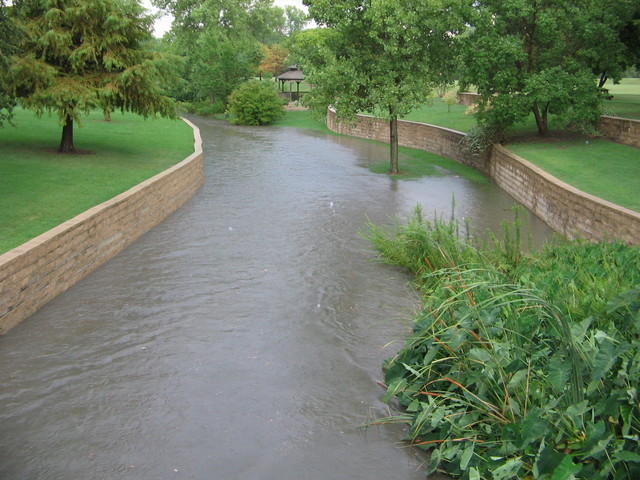
 [1948h]
[1948h]

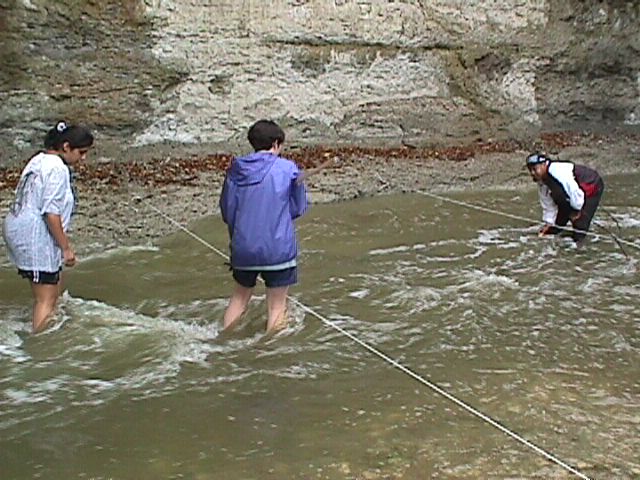
![\begin{figure}\centering\includegraphics[height=3in,bb=0 0 639 479]
{Figs/flowmeter_use.eps.gz}\end{figure}](Timg16.gif)
